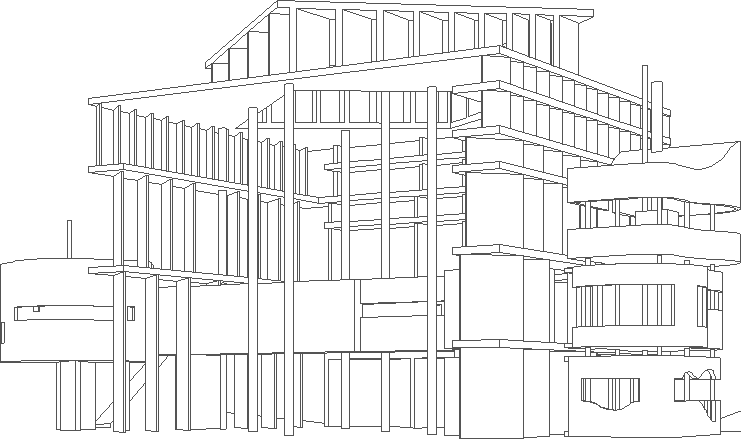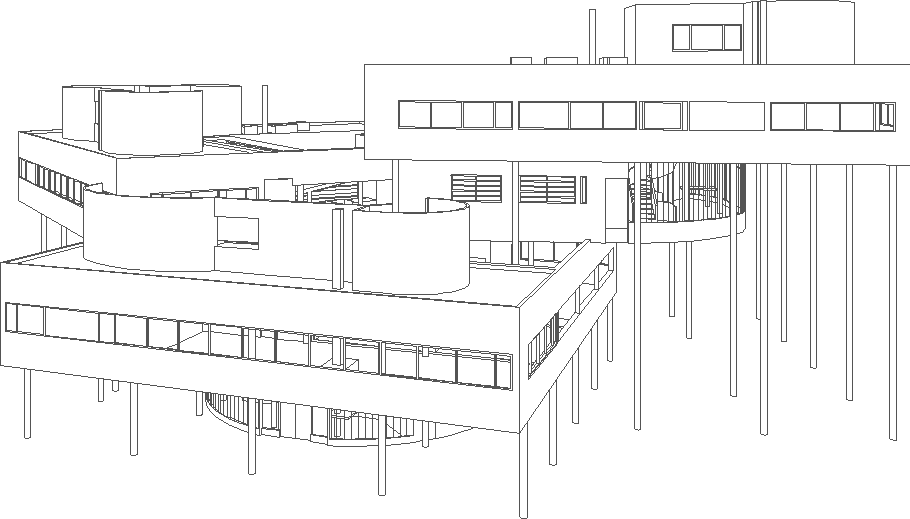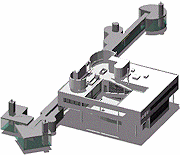2008.11.13
appositional architecture
On 2002.02.03 I wrote a note regarding "appositional art" and also the notion of wqc/appositions, but concluded with not being sure what appositional architecture is. It now seems that I do know what appositional architecture is, and I've been doing it via the "recombinant architectures" and IQ and even the first two Houses for Otto, House of Ill-Repute 001, Le Composites, Cut & Paste Museum. I can at least begin to collect/list all the examples at Quondam of "appositional Architecture" and outline a display of the work. Begin also by making a CAD database collection of the various plans.
There seems to be a thin line between appositional (architecture) and superimpositional (architecture), yet the 3-dimensional nature of architecture actually can simultaneously accommodate apposition and superimposition. For example, the HQ of DATA is appositional in elevation and superimpositional in plan. (...which now reminds me that there are no hline elevations of HQ of DATA.) I like this interesting double aspect that architecture can facilitate (and I wonder if this could be part of "Surgical Double Theater"--yes).
Actually "Going into Eclectic Shock" was/is going to be about my recombinant architectures, so either it all somehow comes together or it begins to interfere, or contradict. [2009.04.07: eclectic shock could deal with mixing/recombining architectures from different eras into new wholes.] Is appositional architecture and superimpositional architecture somehow going to be the overriding aspect/motif of AinCC?
Anyway, look at/collect the appositional letters/arguments and further develop them.
2008.12.03 01:50
where is the good new architecture?
I'm sorry, but I just don't see arbitrary calendar dates and market value events as some kind of cause-and-effect ways to analyze, evaluate or categorize the evolution of architectural design. You mention the connection of Eisenman to CCTV, and I find that more relevant then whether CCTV is on a/your list of top 5 21st century buildings so far. And look at Le Corbusier's St. Pierre at Firminy-Vert, designed 1962, finally built a few years ago. Also Hedjuk's Bye House.
I prefer to watch architecture history as it actually unfolds, and not through the aperture of somewhat artificial markers.
2009.01.19
museum musings
The impossibility of using has its emblematic place in the Museum. The muse[um]ification of the world is today an accomplished fact. One by one, the spiritual potentialities that defined the people's lives--art, religion, philosophy the idea of nature, even politics--have docilely withdrawn into the Museum. "Museum" here is not a given physical space or place but the separate dimension to which what was once--but is no longer--felt as true and decisive has moved. In this sense, the Museum can coincide with an entire city (such as Evora and Venice, which were declared World Heritage Sites), a region (when it is declared a park or natural preserve), and even a group of individuals (in so far as they represent a form of life that has disappeared). But more generally, everything today can become a Museum, because this term simply designates the exhibition of an impossibility of using, of dwelling, of experiencing.
Thus in the Museum, the analogy between capitalism and religion becomes clear. The Museum occupies exactly the space and function once reserved for the Temple as the place of sacrifice. To the faithful in the Temple--the pilgrims who would travel across the earth from temple to temple, from sanctuary to sanctuary--correspond today the tourists who restlessly travel in a world that has been abstracted into a Museum.
--Giorgio Agamben, "In Praise of Profanation" (2007).
The above links [to The Recombinant Reenactment] ridiculously abuse Corb and Hejduk.
I was referring to the Hejduk Bye House Corb Tower of Shadows hybrid in the above link. Just because it is play does not make it good, intelligent, conceptual, valuable, interesting, helpful, informative, hitsorically [sic] clarifying, operative, critical or worthwhile.
--fku2 (2008)
...garage sale as museum...
joke from the early 1980s:
A: What comes after museum?
Q: pre-shrine
--[dis]content .20
Museum as future-shock, sort of. Pick your destiny.
--Positive notes
Use your museums, especially if they're not there to begin with.
--2009.01.19
| |
2009.06.21 14:58
please comment or destroy, thank you
Like I already said:
"I can well see that scripting is an advancement in drawing dexterity with the aim of an advancement in production, but it's not altogether evident that scripting is an advancement in architecture."
abstract 0.0
Ichnographia Quondam
Advancements in virtual architecture, yes. But does an advancement in virtual architecture necessarily or automatically translate into an advancement in real architecture?
Is this an advancement in architecture?
Is this an advancement in architecture?

Is this an advancement in architecture?

Is this an advancement in architecture?

| |
2009.07.02
Villa + 15

 2409
2409
2010.05.12 13:13
Neil Denari vs. Diller Scofido Renfro vs.
In summer 1991, Harvard's Loeb Library purchased a drawings and slides analysis of Le Corbusier's Palais des Congrès à Strasbourg.
3121d-3122o
3122q*
*uncanny
2010.05.12 16:24
Neil Denari vs. Diller Scofido Renfro vs.
House 10:Museum (Hejduk), 1963-67
Palais des Congres a Strasbourg (Le Corbusier), 1964
Palm Bay Congres Center, Agadir (OMA), 1990
Palais des Congres a Strasbourg analysis (Arcadia), 1991
Deux Bibliotheques Jussieu (OMA), 1992
Educatorium (OMA), 1993-97
VPRO (MVRDV), 1993-97
Azadi Cineplex (FOA), 1996
Virtual House (FOA), 1997
2010.12.22 17:14
Predict the new "-ism" for 2011.
Esqueism
as in ism is out and esque is in
Romanesqueesque
Industrialesque
Modernesque
Post-Modernesque
Deconstructionistesque
Boxesque
Blobesque
Furnessesque
LouisIKahnesque
Stirlingesque
Hejdukesque
ScottBrownesque
Eisenmanesque
OMAesque
HdMesque
MVRDVesque
Zahaesque
Whiteesque
Grayesque
Greenesque
|